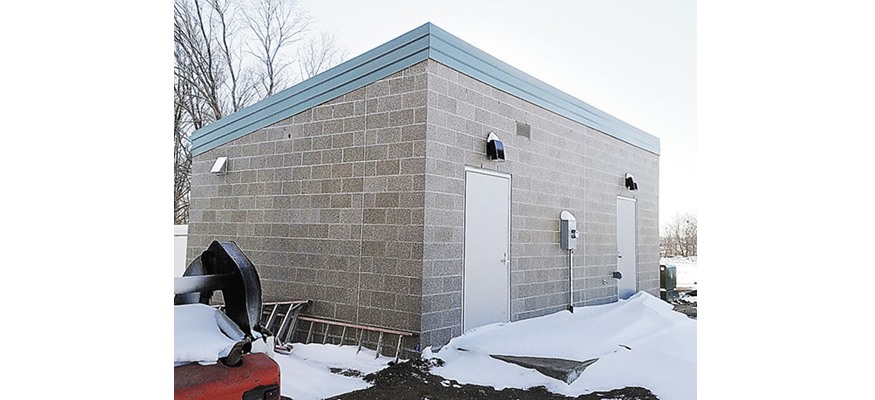
Photo by Chuck Clement: GRIDOR CONSTRUCTION workers completed building the roof for the new Madison meter house and are currently installing the process piping that will help the city's water department connect to the Big Sioux Community Water System. City and Lewis & Clark officials plan to have the city receiving additional water before the end of January.
By Chuck Clement, Staff Reporter, Courtesy of Madison Daily Leader
The head of the Lewis & Clark water pipeline announced last week that the construction work needed to connect pipes to Madison should see completion by the end of December.
Troy Larson, executive director for the Lewis & Clark Regional Water System, said the new pipeline section near Sioux Falls should reach operational status by the end of this week. Larson expects to receive a "green light" for the 5-mile Sioux Falls section, also referred to as Section 1, when the results for bacteriological testing are delivered to LCRWS offices.
According to Larson, Section 1 has already undergone successful pressure testing.
Winter Brothers Underground of Sioux Falls was awarded the $2.95 million contract to construct two segments of a Madison service line. The two segments consist of 5 miles of 16-inch pipe northwest of Sioux Falls and 5 miles of 14-inch pipe east of Madison.
Section 5, the pipeline section that crews installed east of Madison, has a construction schedule running about one week later than Section 1, according to Larson. Workers should start the disinfection process for the Madison-area segment this week.
"It looks like everything should be completed by the end of this month," Larson said.
The new pipeline segments are part of the "wheeling plan" which -- along with utilizing infrastructure operated by the Minnehaha Community Water Corporation and Big Sioux Community Water System -- will allow Madison to access up to 1 million gallons of water daily.
Construction on the two pipeline segments started this summer.
In late July, construction workers in Madison also started preparing a site near the municipal water-treatment plant as the location for a LCRWS meter house.
Last March, LCRWS officials opened bids for a contract to construct meter houses in Madison and Crooks. Gridor Construction of Buffalo, Minn., was awarded the contract for its bid of $1.42 million.
Larson said the substantial completion date for the meter houses was set for Jan. 8. However, due to some delays, officials may delay by a couple of weeks the actual operating date for the Madison facility.
According to Larson, the Gridor work crew has completed the roof for the Madison meter building. The workers are currently completing the installation of the facility's process piping. Larson currently expects Madison to receive its additional water sometime between Jan. 8 and Jan. 20.
Chad Comes, Madison's city engineer and a LCRWS board member, said that the city is prepared for the new water source.
"Everything is connected," Comes said. "Big Sioux (Community Water System) is actually able to provide us with water now."
Currently, Madison and Big Sioux are completing the installation and operational-use of ammonia-based water treatment systems to "...get those systems up and running." At current time, the workers are performing disinfection within the new water system additions.
"We want to wait on those connections until each of us -- Big Sioux and Madison -- has their own ammonia system operating," Comes said.
In early December, staff with the Madison Water Department changed the disinfectant that the city used from chlorine to chloramines. The switch to chloramines should reduce the levels of disinfection by-products (DBPs) in the municipal water system, while still providing Madison residents with protection from waterborne disease.
However, the change to chloramines can cause problems to persons dependent on dialysis machines. A condition known as hemolytic anemia can occur if the disinfectant is not completely removed from the water that is used for the dialysate.
The pretreatment scheme used for the dialysis units must include some means, such as a charcoal filter, for removing the chloramines. Medical personnel should also determine if additional precautions are required for other medical equipment.
In addition, fish may find chloraminated water toxic. If a Madison resident maintains a fish tank, he or she should make certain that the chemicals and/or filters that the tank uses were designed for use in water that has been treated with chloramines. The fish owner may also need to change the type of filter used for the fish tank.